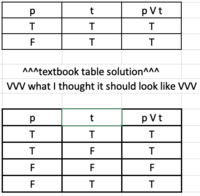love/hatewithMath
New member
- Joined
- Sep 22, 2020
- Messages
- 12
Good to be back. This time, I'm comparing a truth table that I drafted to my textbook solution. First, I'll show them both. Then, I'll tell you what it is about them that I don't understand:

What I don't get about this is that the textbook solution, the table on top in the image above, omits scenarios in which p is FALSE and t is FALSE and the one in which p is TRUE and t is FALSE. Why are these scenarios unnecessary? Are they impossible, unuseful, or something else?

What I don't get about this is that the textbook solution, the table on top in the image above, omits scenarios in which p is FALSE and t is FALSE and the one in which p is TRUE and t is FALSE. Why are these scenarios unnecessary? Are they impossible, unuseful, or something else?
